ECU Acura CL 2003 User Guide
[x] Cancel search | Manufacturer: ACURA, Model Year: 2003, Model line: CL, Model: Acura CL 2003Pages: 355, PDF Size: 4.18 MB
Page 38 of 355
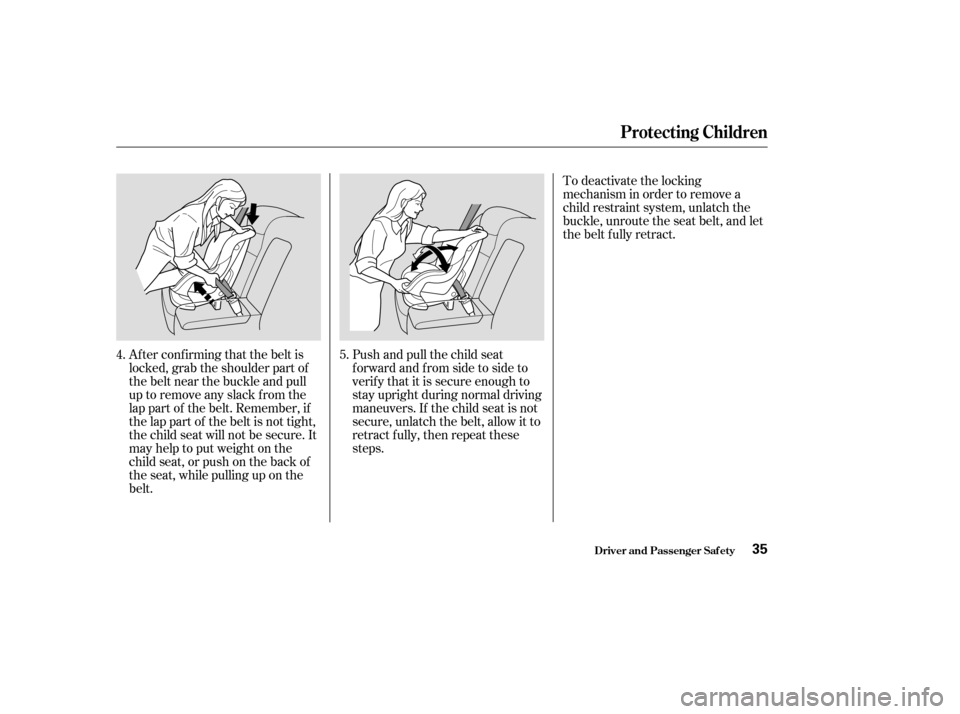
Af ter conf irming that the belt is
locked, grab the shoulder part of
the belt near the buckle and pull
up to remove any slack from the
lap part of the belt. Remember, if
the lap part of the belt is not tight,
the child seat will not be secure. It
mayhelptoputweightonthe
child seat, or push on the back of
the seat, while pulling up on the
belt.Push and pull the child seat
f orward and f rom side to side to
verif y that it is secure enough to
stay upright during normal driving
maneuvers. If the child seat is not
secure, unlatch the belt, allow it to
retract f ully, then repeat these
steps.To deactivate the locking
mechanism in order to remove a
child restraint system, unlatch the
buckle, unroute the seat belt, and let
the belt fully retract.
4. 5.
Protecting Children
Driver and Passenger Saf ety35
Page 41 of 355
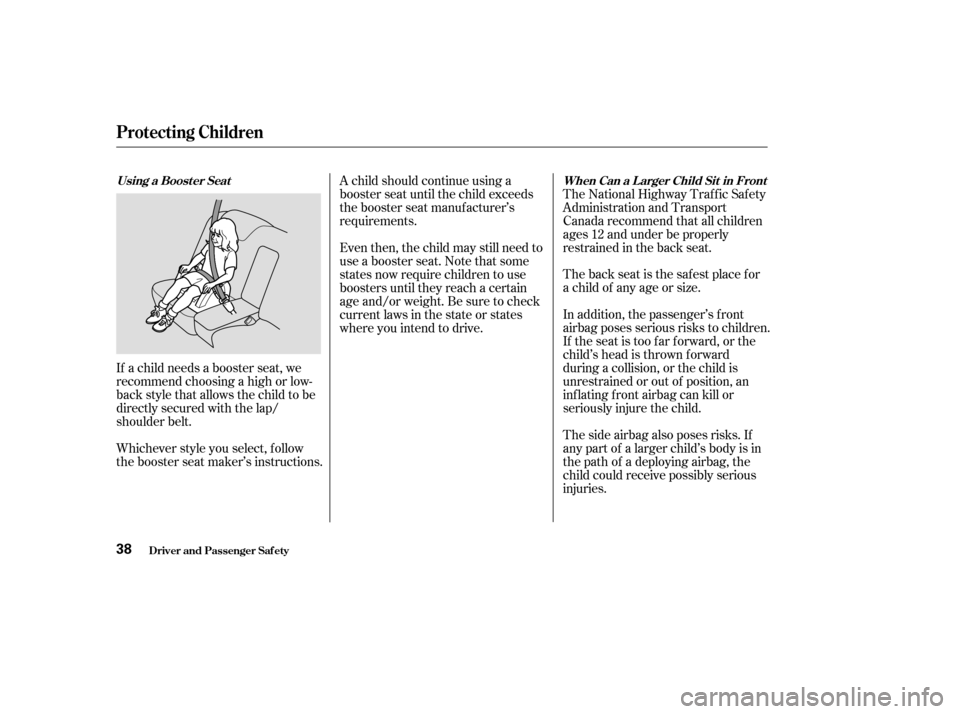
The back seat is the safest place for
a child of any age or size.
In addition, the passenger’s f ront
airbag poses serious risks to children.
If the seat is too f ar f orward, or the
child’s head is thrown f orward
during a collision, or the child is
unrestrained or out of position, an
inf lating f ront airbag can kill or
seriously injure the child.
The side airbag also poses risks. If
any part of a larger child’s body is in
the path of a deploying airbag, the
child could receive possibly serious
injuries.
Whichever style you select, f ollow
the booster seat maker’s instructions. The National Highway Traffic Safety
Administration and Transport
Canada recommend that all children
ages 12 and under be properly
restrained in the back seat.
If a child needs a booster seat, we
recommend choosing a high or low-
back style that allows the child to be
directly secured with the lap/
shoulder belt. A child should continue using a
booster seat until the child exceeds
the booster seat manufacturer’s
requirements.
Even then, the child may still need to
use a booster seat. Note that some
states now require children to use
boosters until they reach a certain
ageand/orweight.Besuretocheck
current laws in the state or states
where you intend to drive.
When Can a Larger Child Sit in Front
Using a Boost er Seat
Protecting Children
Driver and Passenger Saf ety38
Page 42 of 355

Of course, children vary widely. And
while age may be one indicator of
when a child can saf ely ride in the
f ront, there are other important
f actors you should consider.If you decide that a child can saf ely
ride up f ront, be sure to:
Caref ully read the owner’s manual
and make sure you understand all
seat belt instructions and all saf ety
inf ormation.
Move the vehicle seat to the rear-
most position.
Have the child sit up straight, back
against the seat, and feet on or
near the f loor.
Check that the child’s seat belt is
properly positioned and secured.
Physically, a child must be large
enough f or the lap/shoulder belt to
properly f it over the hips, chest, and
shoulder (see pages and ). If
the seat belt does not f it properly,
the child should not sit in the f ront.
To saf ely ride in f ront, a child must
be able to f ollow the rules, including
sitting properly and wearing the seat
belt properly throughout a ride.
Remind the child not to lean
toward the door.
Supervise the child. Even mature
children sometimes need to be
reminded to f asten the seat belts
or sit properly.
15 37Physical Size
Maturity
Protecting Children
Driver and Passenger Saf ety39
Page 43 of 355
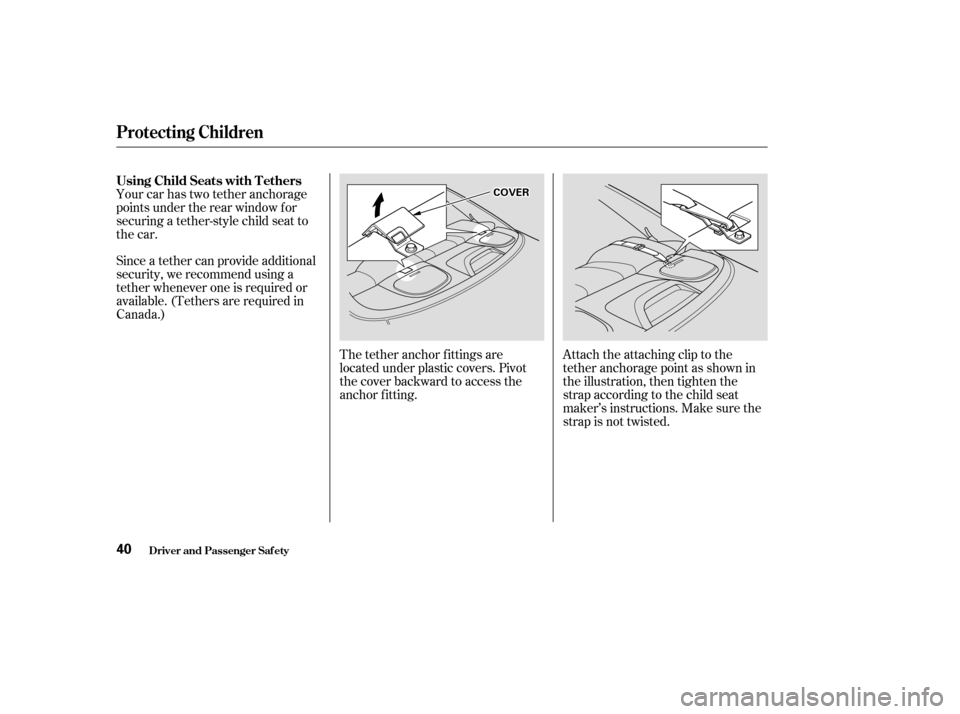
Attach the attaching clip to the
tether anchorage point as shown in
the illustration, then tighten the
strap according to the child seat
maker’s instructions. Make sure the
strap is not twisted.
The tether anchor f ittings are
located under plastic covers. Pivot
the cover backward to access the
anchor fitting.
Your car has two tether anchorage
points under the rear window f or
securing a tether-style child seat to
the car.
Since a tether can provide additional
security, we recommend using a
tether whenever one is required or
available. (Tethers are required in
Canada.) Using Child Seats with T ethers
Protecting Children
Driver and Passenger Saf ety40
C CO
OV VE
ER
R
Page 44 of 355
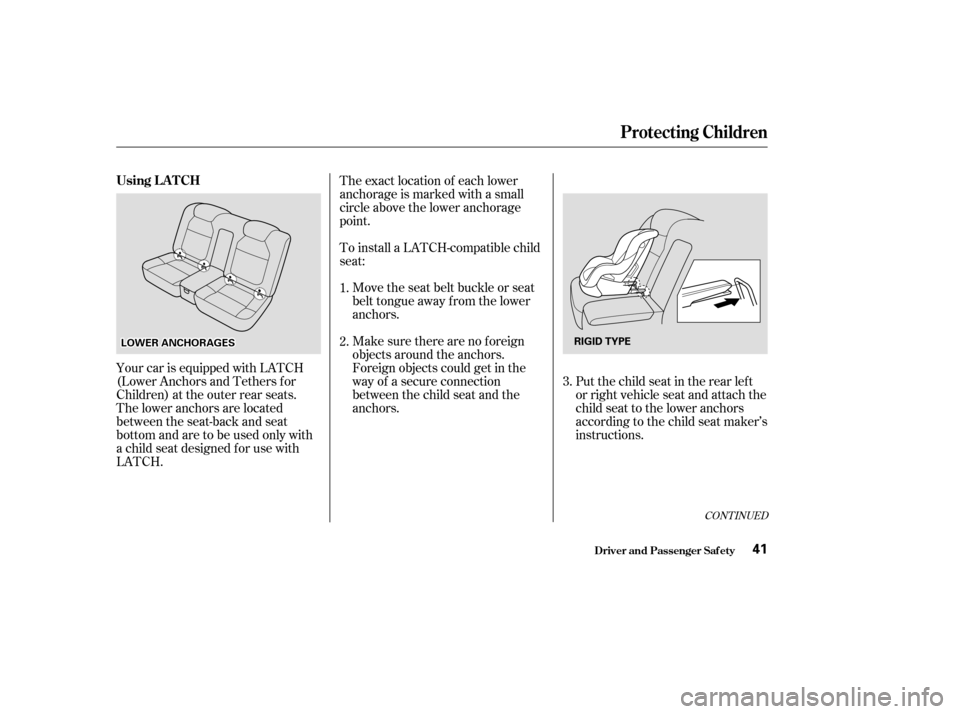
Your car is equipped with LATCH
(Lower Anchors and Tethers f or
Children) at the outer rear seats.
The lower anchors are located
between the seat-back and seat
bottom and are to be used only with
a child seat designed f or use with
LATCH.The exact location of each lower
anchorage is marked with a small
circle above the lower anchorage
point.
To install a LATCH-compatible child
seat:
Move the seat belt buckle or seat
belt tongue away f rom the lower
anchors.
Put the child seat in the rear lef t
or right vehicle seat and attach the
child seat to the lower anchors
according to the child seat maker’s
instructions.
Make sure there are no f oreign
objects around the anchors.
Foreign objects could get in the
way of a secure connection
between the child seat and the
anchors.
3.
1.
2.
CONT INUED
Protecting Children
Driver and Passenger Saf ety
Using L A T CH
41
L LO
OW WE ER
R A
AN
NC CHH O
OR RAA G
GE ES
S RIGID TYPE
Page 45 of 355
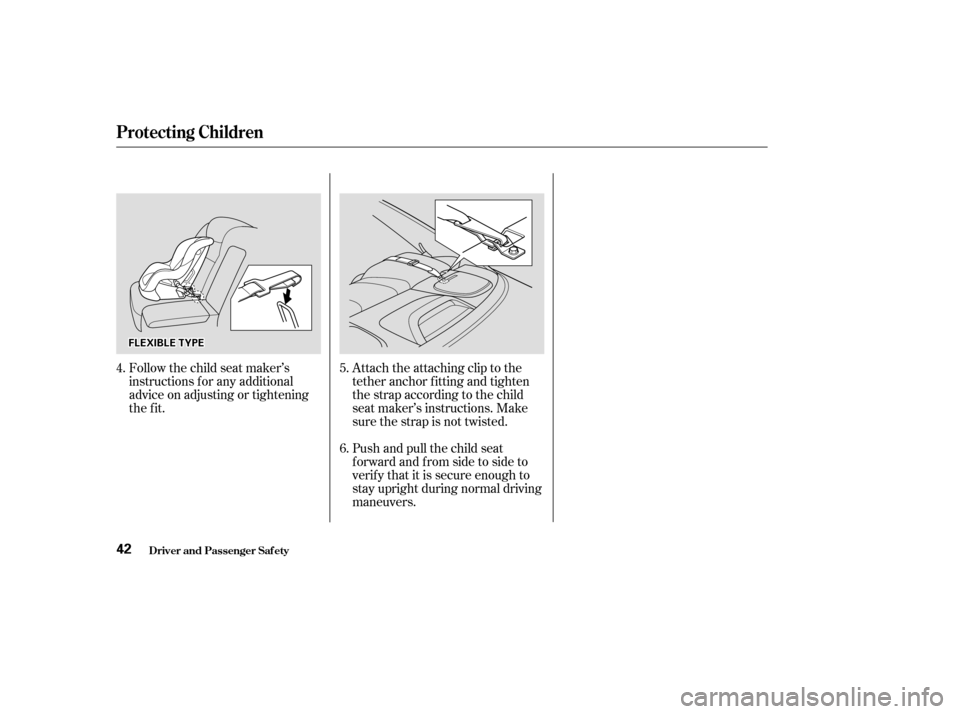
Follow the child seat maker’s
instructions f or any additional
advice on adjusting or tightening
the fit.Attach the attaching clip to the
tether anchor fitting and tighten
the strap according to the child
seat maker’s instructions. Make
sure the strap is not twisted.
Push and pull the child seat
f orward and f rom side to side to
verif y that it is secure enough to
stay upright during normal driving
maneuvers.
4.
5.
6.
Protecting Children
Driver and Passenger Saf ety42
F FL
LEE X
X I
IBBL LEE T
TY
YP PE
E
Page 46 of 355
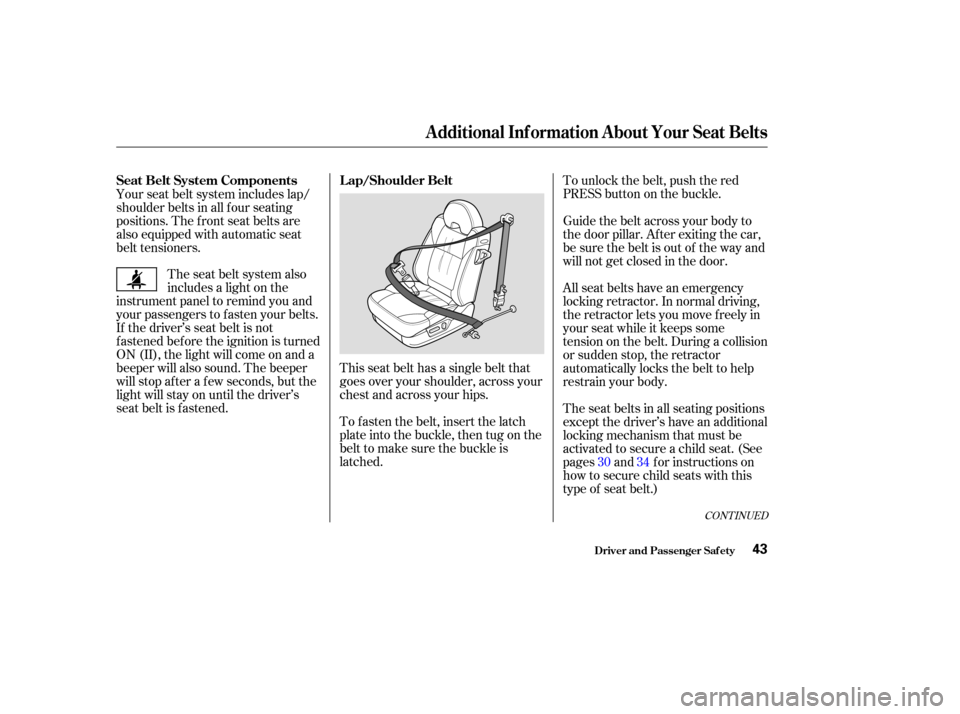
This seat belt has a single belt that
goes over your shoulder, across your
chest and across your hips.To unlock the belt, push the red
PRESSbuttononthebuckle.
To fasten the belt, insert the latch
plate into the buckle, then tug on the
belt to make sure the buckle is
latched.
The seat belt system also
includes a light on the
instrument panel to remind you and
your passengers to f asten your belts.
If the driver’s seat belt is not
fastened before the ignition is turned
ON (II), the light will come on and a
beeper will also sound. The beeper
will stop af ter a f ew seconds, but the
light will stay on until the driver’s
seat belt is f astened. Your seat belt system includes lap/
shoulder belts in all f our seating
positions. The f ront seat belts are
also equipped with automatic seat
belt tensioners. Guide the belt across your body to
the door pillar. Af ter exiting the car,
be sure the belt is out of the way and
will not get closed in the door.
All seat belts have an emergency
locking retractor. In normal driving,
the retractor lets you move f reely in
your seat while it keeps some
tension on the belt. During a collision
or sudden stop, the retractor
automatically locks the belt to help
restrain your body.
The seat belts in all seating positions
except the driver’s have an additional
locking mechanism that must be
activated to secure a child seat. (See
pages and f or instructions on
how to secure child seats with this
type of seat belt.)30 34
CONT INUED
Seat Belt System Components L ap/Shoulder Belt
Additional Inf ormation About Your Seat Belts
Driver and Passenger Saf ety43
Page 80 of 355
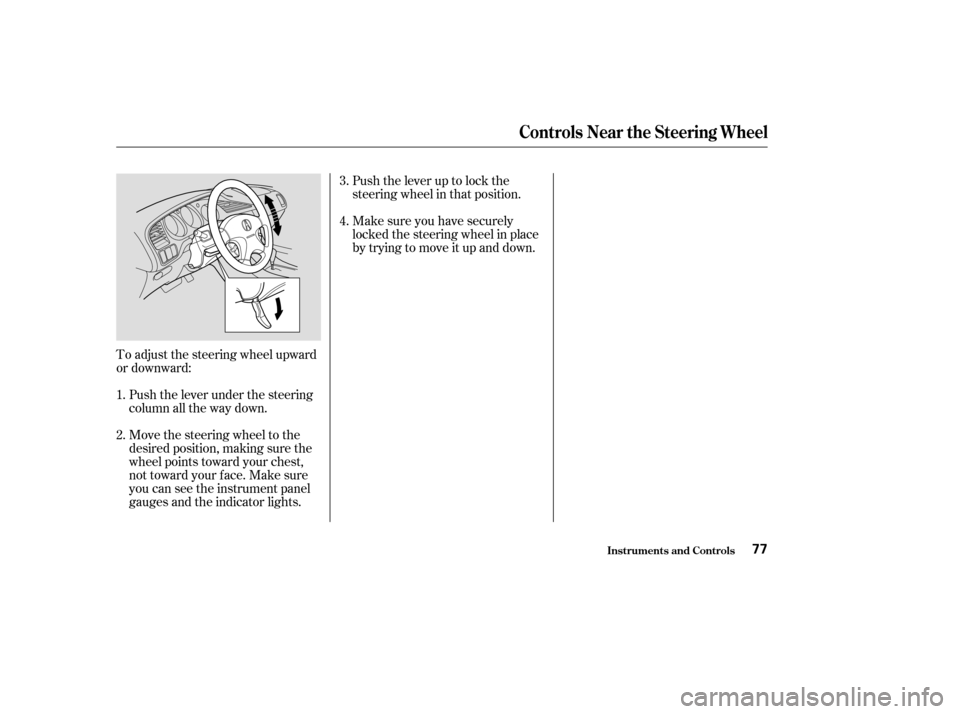
To adjust the steering wheel upward
or downward:Push the lever under the steering
column all the way down.
Move the steering wheel to the
desired position, making sure the
wheel points toward your chest,
not toward your f ace. Make sure
you can see the instrument panel
gauges and the indicator lights. Push the lever up to lock the
steering wheel in that position.
Make sure you have securely
locked the steering wheel in place
by trying to move it up and down.
1.
2. 3.
4.
Controls Near the Steering Wheel
Inst rument s and Cont rols77
Page 86 of 355
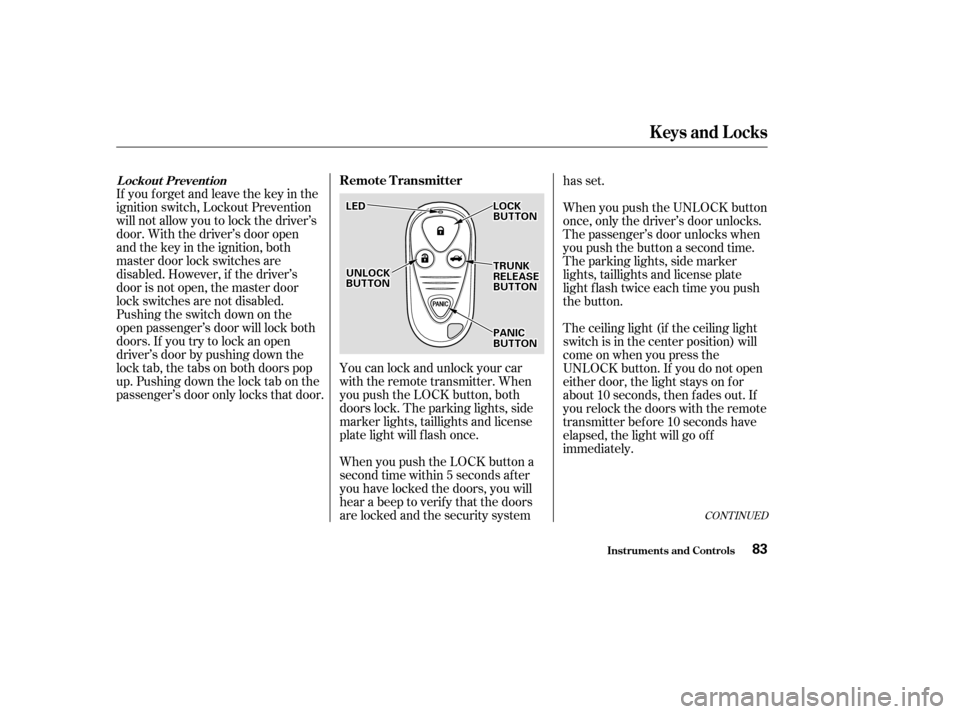
If you f orget and leave the key in the
ignition switch, Lockout Prevention
will not allow you to lock the driver’s
door. With the driver’s door open
andthekeyintheignition,both
master door lock switches are
disabled. However, if the driver’s
door is not open, the master door
lock switches are not disabled.
Pushing the switch down on the
open passenger’s door will lock both
doors. If you try to lock an open
driver’s door by pushing down the
lock tab, the tabs on both doors pop
up. Pushing down the lock tab on the
passenger’s door only locks that door.You can lock and unlock your car
with the remote transmitter. When
you push the LOCK button, both
doors lock. The parking lights, side
marker lights, taillights and license
plate light will f lash once.
When you push the LOCK button a
second time within 5 seconds after
you have locked the doors, you will
hear a beep to verify that the doors
arelockedandthesecuritysystemhas set.
When you push the UNLOCK button
once, only the driver’s door unlocks.
The passenger’s door unlocks when
you push the button a second time.
The parking lights, side marker
lights, taillights and license plate
light f lash twice each time you push
the button.
The ceiling light (if the ceiling light
switch is in the center position) will
come on when you press the
UNLOCK button. If you do not open
either door, the light stays on f or
about 10 seconds, then f ades out. If
you relock the doors with the remote
transmitter before 10 seconds have
elapsed, the light will go of f
immediately.
CONT INUED
Remote TransmitterL ockout Prevent ion
Keys and Locks
Inst rument s and Cont rols83
L L
E
E D
D
U
UN NLLO
OC CKK
B
BU UT TT
TO
ON N L
L
O
OC CKK
B
BU UT TT
TO
ON N
T
T R
RU UN NKK
R
RE EL
LE
E A
A S
SEE
B
BU UT TT
TO
ON N
P
P A
A N
NI ICC
B
BU UT TT
TO
ON N
Page 87 of 355
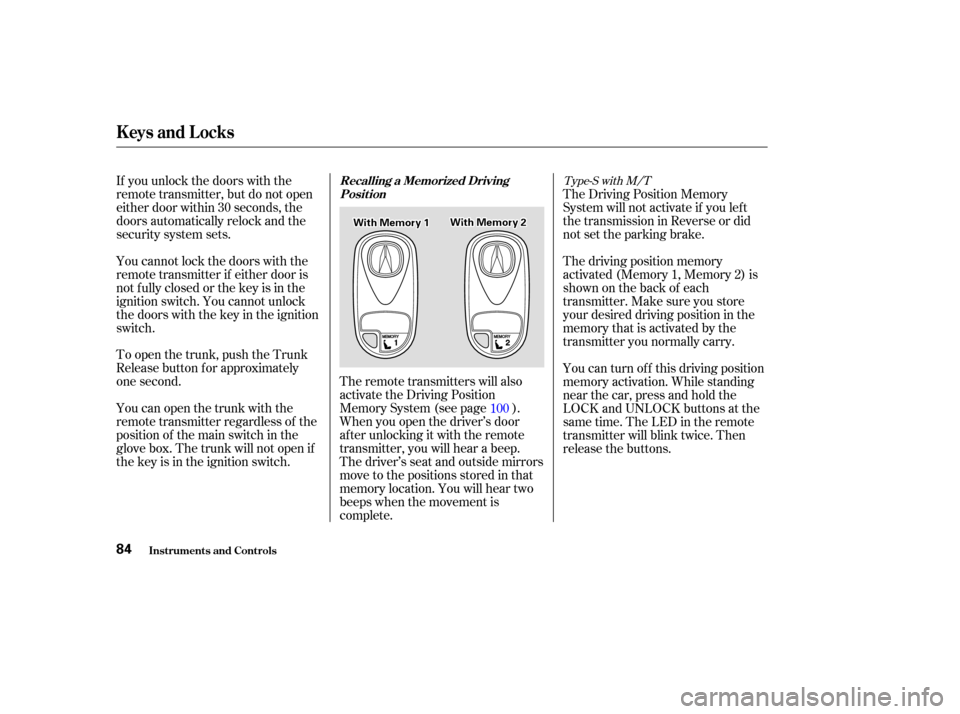
Theremotetransmitterswillalso
activate the Driving Position
Memory System (see page ).
When you open the driver’s door
after unlocking it with the remote
transmitter, you will hear a beep.
The driver’s seat and outside mirrors
move to the positions stored in that
memory location. You will hear two
beeps when the movement is
complete.
If you unlock the doors with the
remote transmitter, but do not open
either door within 30 seconds, the
doors automatically relock and the
security system sets.
You cannot lock the doors with the
remote transmitter if either door is
not f ully closed or the key is in the
ignition switch. You cannot unlock
the doors with the key in the ignition
switch.
To open the trunk, push the Trunk
Release button f or approximately
one second.
You can open the trunk with the
remote transmitter regardless of the
position of the main switch in the
glove box. The trunk will not open if
the key is in the ignition switch.
The Driving Position Memory
System will not activate if you lef t
the transmission in Reverse or did
not set the parking brake.
The driving position memory
activated (Memory 1, Memory 2) is
shownonthebackof each
transmitter. Make sure you store
your desired driving position in the
memory that is activated by the
transmitter you normally carry.
You can turn of f this driving position
memory activation. While standing
near the car, press and hold the
LOCK and UNLOCK buttons at the
same time. The LED in the remote
transmitter will blink twice. Then
release the buttons.
100
Type-S with M/T
Recalling a Memorized Driving
Position
Keys and Locks
Inst rument s and Cont rols84
W Wi itth h M
M e
emm o
or
ryy 1
1 W
Wi
itth h M
M e
emm o
or
ryy 2
2